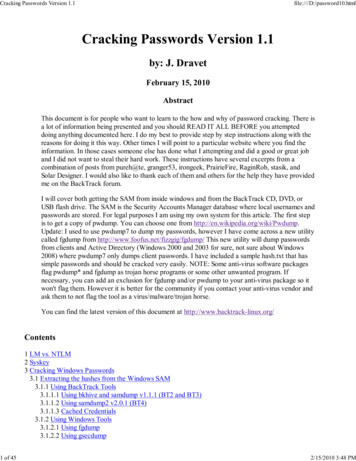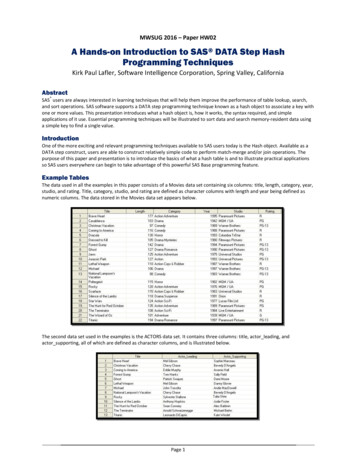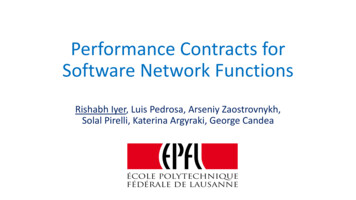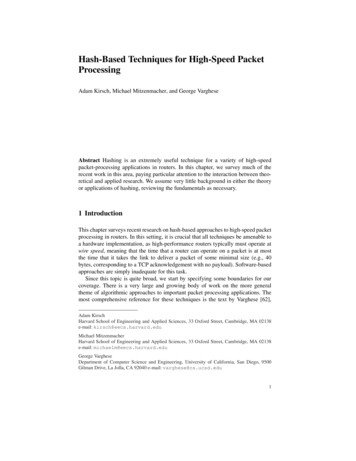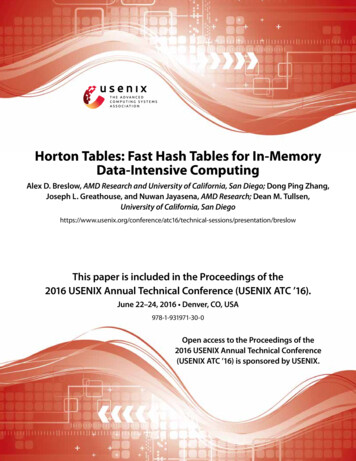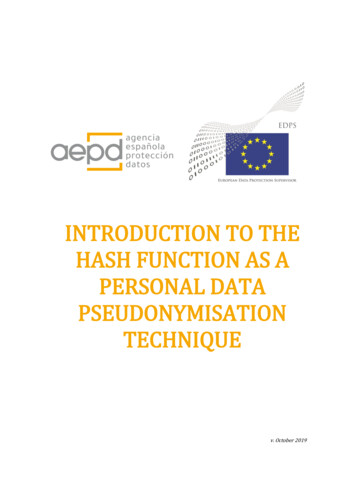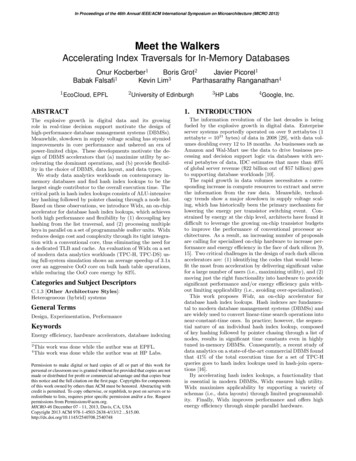
Transcription
A preliminary version of this paper appears in Advances in Cryptology - ASIACRYPT 2006, LectureNotes in Computer Science Vol. 4284, pp. 299-314, X. Lai and K. Chen eds., Springer-Verlag, 2006.This is the full version.Multi-Property-Preserving Hash Domain Extension andthe EMD TransformMihir Bellare Thomas Ristenpart†October 2007AbstractWe point out that the seemingly strong pseudorandom oracle preserving (PRO-Pr) propertyof hash function domain-extension transforms defined and implemented by Coron et. al. [12] canactually weaken our guarantees on the hash function, in particular producing a hash functionthat fails to be even collision-resistant (CR) even though the compression function to which thetransform is applied is CR. Not only is this true in general, but we show that all the transformspresented in [12] have this weakness. We suggest that the appropriate goal of a domain extensiontransform for the next generation of hash functions is to be multi-property preserving, namelythat one should have a single transform that is simultaneously at least collision-resistance preserving, pseudorandom function preserving and PRO-Pr. We present an efficient new transformthat is proven to be multi-property preserving in this sense.Keywords: Hash functions, random oracle, Merkle-Damgård, collision-resistance, pseudorandomfunction. Dept. of Computer Science & Engineering 0404, University of California San Diego, 9500 Gilman Drive, La Jolla,CA 92093-0404, USA. Email: mihir@cs.ucsd.edu. URL: http://www-cse.ucsd.edu/users/mihir. Supported inpart by NSF grant CNS 0524765 and a gift from Intel Corporation.†Dept. of Computer Science & Engineering 0404, University of California San Diego, 9500 Gilman Drive, LaJolla, CA 92093-0404, USA. Email: tristenp@cs.ucsd.edu. URL: http://www-cse.ucsd.edu/users/tristenp.Supported in part by above-mentioned grants of first author.1
Contents1 Introduction32 Definitions63 Domain Extension using Merkle-Damgård84 Orthogonality of Property Preservation94.1 PRO-Pr does not imply CR-Pr . . . . . . . . . . . . . . . . . . . . . . . . . . . . . . 94.2 Insecurity of Proposed PRO-Pr Transforms . . . . . . . . . . . . . . . . . . . . . . . 115 The5.15.25.3EMD Transform12EMD is CR-Pr . . . . . . . . . . . . . . . . . . . . . . . . . . . . . . . . . . . . . . . 13EMD is PRO-Pr . . . . . . . . . . . . . . . . . . . . . . . . . . . . . . . . . . . . . . 13EMD is PRF-Pr . . . . . . . . . . . . . . . . . . . . . . . . . . . . . . . . . . . . . . 166 Proof of Lemma 5.1176.1 The Simulator . . . . . . . . . . . . . . . . . . . . . . . . . . . . . . . . . . . . . . . . 176.2 Bounding A’s Advantage . . . . . . . . . . . . . . . . . . . . . . . . . . . . . . . . . . 18A Families of Compression and Hash Functions229
1IntroductionBackground. Recall that hash functions are built in two steps. First, one designs a compressionfunction h: {0, 1}d n {0, 1}n , where d is the length of a data block and n is the length of thechaining variable. Then one specifies a domain extension transform H that utilizes h as a blackbox to implement the hash function H h : {0, 1} {0, 1}n associated to h. All widely-used hashfunctions use the Merkle-Damgård (MD) transform [16, 13] because it has been proven [16, 13] tobe collision-resistance preserving (CR-Pr): if h is collision-resistant (CR) then so is H h . This meansthat the cryptanalytic validation task can be confined to the compression function.A rising bar. Current usage makes it obvious that CR no longer suffices as the security goalfor hash functions. In order to obtain MACs and PRFs, hash functions were keyed. The canonicalconstruct in this domain is HMAC [4, 2] which is widely standardized and used. (NIST FIPS198, ANSI X9.71, IETF RFC 2104, SSL, SSH, IPSEC, TLS, IEEE 802.11i, and IEEE 802.16e areonly some instances.) Hash functions are also used to instantiate random oracles [6] in public-keyschemes such as RSA-OAEP [7] and RSA-PSS [8] in the RSA PKCS#1 v2.1 standard [18]. CR isinsufficient for arguing the security of hash function based MACs or PRFs, let alone hash-functionbased random oracles. And it does not end there. Whether hash function designers like it ornot, application builders will use hash functions for all kinds of tasks that presume beyond-CRproperties. Not all such uses can be sanctified, but the central and common ones should be. Wethink that the type of usage we are seeing for hash functions will continue, and it is in the bestinterests of security to make the new hash functions rise as far towards this bar as possible, bymaking them strong and versatile tools that have security attributes beyond CR.This paper. Towards the goal of building strong, multi-purpose hash functions, our focus ison domain extension, meaning we wish to determine which domain extension transforms are bestsuited to this task. The first part of our work examines a natural candidate, namely transforms thatare pseudorandom oracle preserving as per [12], and identifies some weaknesses of this goal. Thismotivates the second part, where we introduce the notion of a multi-property preserving (MPP)transform, argue that this should be the target goal, and present and prove the correctness of anefficient MPP transform that we refer to as EMD. Let us now look at all this in more depth.Random-oracle preservation. Coron, Dodis, Malinaud and Puniya [12] make the importantobservation that random oracles are modeled as monolithic entities (i.e., are black boxes workingon domain {0, 1} ), but in practice are instantiated by hash functions that are highly structureddue to the design paradigm described above, leading for example to the extension attack. Theirremedy for this logical gap is to suggest that a transform H be judged secure if, when modeling has a fixed-input-length random oracle, the resulting scheme H h behaves like a random oracle. Theygive a formal definition of “behaving like a random oracle” using the indifferentiability frameworkof Maurer et al. [14]. We use the moniker pseudorandom oracle to describe any construction that isindifferentiable from a random oracle. (Note that a random oracle itself is always a pseudorandomoracle.) The framework has the desirable property that any scheme proven secure in the randomoracle model of [6] is still secure when we replace the random oracles with pseudorandom oracles.We call the new security goal of [12] pseudorandom oracle preservation (PRO-Pr). They proposefour transforms which they prove to be PRO-Pr.PRO-Pr seems like a very strong property to have. One reason one might think this is that itappears to automatically guarantee that the constructed hash function has many nice properties.For example, that the hash function created by a PRO-Pr transform would be CR. Also that thehash function could be keyed in almost any reasonable way to yield a PRF and MAC. And so on.This would be true, because random oracles have these properties, and hence so do pseudorandom3
oracles. Thus, one is lead to think that one can stop with PRO-Pr: once the transform has thisproperty, we have all the attributes we desire from the constructed hash function.Weakness of PRO-Pr. The first contribution of this paper is to point out that the above reasoningis flawed and there is a danger to PRO-Pr in practice. Namely, the fact that a transform is PRO-Prdoes not guarantee that the constructed hash function is CR, even if the compression function isCR. We demonstrate this with a counter-example. Namely we give an example of a transform thatis PRO-Pr, yet there is a CR compression function such that the hash function resulting from thetransform is not CR. That is, the transform is PRO-Pr but not CR-Pr, or, in other words, PRO-Prdoes not imply CR-Pr. What this shows is that using a PRO-Pr transform could be worse thanusing the standard, strengthened Merkle-Damgård transform from the point of view of securitybecause at least the latter guarantees the hash function is CR if the compression function is, butthe former does not. If we blindly move to PRO-Pr transforms, our security guarantees are actuallygoing down, not up.How can this be? It comes about because PRO-Pr provides guarantees only if the compressionfunction is a random oracle or pseudorandom oracle. But of course any real compression functionis provably not either of these. (One can easily differentiate it from a random oracle because it canbe computed by a small program.) Thus, when a PRO-Pr transform works on a real compressionfunction, we have essentially no provable guarantees on the resulting hash function. This is in someways analogous to the kinds of issues pointed out in [11, 3] about the sometimes impossibility ofinstantiating random oracles.The transforms of [12] are not CR-Pr. The fact that a PRO-Pr transform need not in general be CR-Pr does not mean that some particular PRO-Pr transform is not CR-Pr. We thereforeinvestigate each of the four PRO-Pr schemes suggested by [12]. The schemes make slight modifications to the MD transform: the first applies a prefix-free encoding, the second “throws” awaysome of the output, and the third and fourth utilize an extra compression function application.Unfortunately, we show that none of the four transforms is CR-Pr. We do this by presenting anexample CR compression function h such that applying each of the four transforms to it results in ahash function for which finding collisions is trivial. In particular, this means that these transformsdo not provide the same guarantee as the existing and in-use Merkle-Damgård transform. For thisreason we think these transforms should not be considered suitable for use in the design of newhash functions.What this means. We clarify that we are not suggesting that the pseudorandom oracle preservation goal of [12] is unimportant or should not be achieved. In fact we think it is a very goodidea and should be a property of any new transform. This is so because in cases where we are(heuristically) assuming the hash function is a random oracle, this goal reduces the assumptionto the compression function being a random oracle. What we have shown above, however, is thatby itself, it is not enough because it can weaken existing, standard-model guarantees. This leadsto the question of what exactly is enough, or what we should ask for in terms of a goal for hashdomain extension transforms.MPP transforms. The two-step design paradigm in current use is compelling because it reducesthe cryptanalytic task of providing CR of the hash function to certifying only that the compressionfunction has the same property. It makes sense to seek other attributes via the appropriate extensionof this paradigm. We suggest that, if we want a hash function with properties P1 , . . . , Pn then weshould (1) design a compression function h with the goal of having properties P1 , . . . , Pn , and (2)apply a domain extension transform H that provably preserves Pi for every i [1.n]. We callsuch a compression function a multi-property one, and we call such a transform a multi-property-4
TransformPlain MD (MD)Strengthened MD (SMD)Prefix-Free (PRE)Chop Solution (CHP)NMAC Construction (NT)HMAC Construction (HT)Enveloped MD (EMD)CR-PrNo[16, 13]NoNoNoNo[16]PRO-PrNoNo[12][12][12][12]Thm. 5.2PRF-PrNoNo[5]?Thm. 5.3Uses of h for M b d⌈(b 1)/d⌉⌈(b 1 64)/d⌉⌈(b 1)/(d 1)⌉⌈(b 1)/d⌉1 ⌈(b 1)/d⌉2 ⌈(b 1)/d⌉⌈(b 1 64 n)/d⌉Figure 1: Comparison of transform security and efficiency when applied to a compression functionh: {0, 1}n d {0, 1}n . The last column specifies the number of calls to h needed to hash a b-bit message M (where b d) under each transform and a typical padding function (which minimally adds a bit ofoverhead).preserving domain extension transform (from now on simply an MPP transform). Note that wewant a single transform that preserves multiple properties, resulting in a single, multi-propertyhash function, as opposed to a transform per property which would result in not one but numeroushash functions. We suggest that multi-property preservation is the goal a transform should target.Properties to preserve. Of course the next question to ask is which properties our MPPdomain extension transform should preserve. We wish, of course, that the transform continue to beCR-Pr, meaning that it preserve CR. The second thing we ask is that it be pseudorandom functionpreserving (PRF-Pr). That is, if an appropriately keyed version of the compression function is aPRF then the appropriately keyed version of the hash function must be a PRF too. This goal isimportant due to the many uses of hash functions as MACs and PRFs via keying as mentionedabove. Indeed, if we have a compression function that can be keyed to be a PRF and our transformis PRF-Pr then obtaining a PRF or MAC from a hash function will be simple and the constructioneasy to justify. The final goal we will ask is that the transform be PRO-Pr. Compelling argumentsin favor of this goal were made at length in [12] and briefly recalled above.To be clear, we ask that, for a transform H to be considered suitable, one should do thefollowing. First, prove that H h is CR using only the fact that h is CR. Then show that H h is apseudorandom oracle when h is a pseudorandom oracle. Finally, use some natural keying strategyto key H h and assume that h is a good PRF, then prove that H h is also a good PRF. We notethat such a MPP transform will not suffer from the weakness of the transforms of [12] noted abovebecause it will be not only PRO-Pr but also CR-Pr and PRF-Pr.New transform. There is to date no transform with all the properties above. (Namely, thatit is PRO-Pr, CR-Pr and PRF-Pr.) The next contribution of this paper is a new transform EMD(Enveloped Merkle-Damgård) which is the first to meet our definition of hash domain extensionsecurity: EMD is proven to be CR-Pr, PRO-Pr, and PRF-Pr. The transform is simple and easy toimplement in practice (see the figure in Section 5). It combines two mechanisms to ensure thatit preserves all the properties of interest. The first mechanism is the well-known Merkle-Damgårdstrengthening [16]: we always concatenate an input message with the 64-bit encoding of its length.This ensures that EMD is CR-Pr. The second mechanism is the use of an “envelope” to hidethe internal MD iteration — we apply the compression function in a distinguished way to theoutput of the plain MD iteration. Envelopes in this setting were previously used by the NMACand HMAC constructions [4] to build PRFs out of compression functions, and again in two of thePRO-Pr transforms of [12], which were also based on NMAC and HMAC. We utilize the envelope5
in a way distinct from these prior constructions. Particularly, we include message bits as inputto the envelope, which increases the efficiency of the scheme. Second, we utilize a novel reductiontechnique in our proof that EMD is PRO-Pr to show that simply fixing n bits of the envelope’sinput is sufficient to cause the last application of the random oracle to behave independently withhigh probability. This simple solution allows our transform to be PRO-Pr using a single randomoracle without using the other work-arounds previously suggested (e.g., prefix-free encodings orprepending a block of zeros to input messages). A comparison of various transforms is given inFig. 1.Patching existing transforms. We remark that it is possible to patch the transforms of [12]so that they are CR-Pr. Namely, one could use Merke-Damgård strengthening, which they omitted.However our transform still has several advantages over their transforms. One is that ours ischeaper, i.e. more efficient, and this matters in practice. Another is that ours is PRF-Pr. A resultof [5] implies that one of the transforms of [12] is PRF-Pr, but whether or not this is true for theothers is not clear.Whence the compression function? We do not address the problem of constructing a multiproperty compression function. We presume that this can and will be done. This assumption mightseem questionable in light of the recent collision-finding attacks [19, 20] that have destroyed somehash functions and tainted others. But we recall that for block ciphers, the AES yielded by the NISTcompetition was not only faster than DES but seems stronger and more elegant. We believe it will bethe same for compression functions, namely that the planned NIST hash function competition willlead to compression functions having the properties (CR and beyond) that we want, and perhapswithout increase, or even with decrease, in cost, compared to current compression functions. Wealso note that we are not really making new requirements on the compression function; we are onlymaking explicit requirements that are implicit even in current usage.Families of compression functions. Several works [1, 9, 15] consider a setting where compression and hash functions are families rather than individual functions, meaning, like block ciphers,have an extra, dedicated key input. In contrast, we, following [4, 12, 2], adopt the setting of currentpractical cryptographic compression and hash functions where there is no such dedicated key input.An enveloping technique similar to that of EMD is used in the Chain-Shift construction of Maurerand Sjödin [15] for building a VIL MAC out of a FIL MAC in the dedicated key input setting. Wefurther discuss this setting, and their work, in Appendix A.2DefinitionsNotation. Let D {0, 1}d and D i 1 {0, 1}id . We denote pairwise concatenation by ,e.g. M M ′ . We will often write the concatenation of a sequence of string by M1 · · · Mk , whichtranslates to M1 M2 . . . Mk . For brevity, we define the following semantics for the notationdM1 · · · Mk M where M is a string of M bits: 1) define k ⌈ M /d⌉ and 2) if M mod d 0then parse M into M1 , M2 , . . ., Mk where Mi d for 1 i k, otherwise parse M into M1 , M2 ,. . ., Mk 1 , Mk where Mi d for 1 i k 1 and Mk M mod d. For any finite set S we write s S to signify uniformly choosing a value s S.Oracle TMs, random oracles, and transforms. Cryptographic schemes, adversaries, andsimulators are modeled as Oracle Turing Machines (OTM) and are possibly given zero or moreoracles, each being either a random oracle or another OTM (note that when used as an oracle, anOTM maintains state across queries). We allow OTMs to expose a finite number of interfaces: anOTM N (N1 , N2 , . . . , Nl ) exposes interfaces N1 , N2 , . . . , Nl . For brevity, we write MN to signify6
that M gets to query all the interfaces of N. For a set Dom and finite set Rng we define a randomfunction by the following TM accepting inputs X Dom:Algorithm RFDom,Rng (X): if T [X] then T [X] Rngret T [X]where T is a table everywhere initialized to . This implements a random function via lazysampling (which allows us to reason about the case in which Dom is infinite). In the case thatDom {0, 1}d and Rng {0, 1}r we write RFd,r in place of RFDom,Rng . We similarly define RFd,Rngand RFDom,r in the obvious ways and write RF ,r in the special case that Dom {0, 1} . A randomoracle is simply a public random function: all parties (including the adversary) are given access.We write f, g, . . . RFDom,Rng to signify that f , g, . . . are independent random oracles from Domto Rng. A transform C describes how to utilize an arbitrary compression function to create avariable-input-length hash function. When we fix a particular compression function f , we get theassociated cryptographic scheme C f C[f ].Collision resistance. We consider a function F to be collision resistant (CR) if it is computationally infeasible to find any two messages M 6 M ′ such that F (M ) F (M ′ ). For the restof the paper we use h to always represent a collision-resistant compression function with signatureh: {0, 1}d n {0, 1}n .Note our definition of CR is informal. The general understanding in the literature is that aformal treatment requires considering keyed families. But practical compression and hash functionsare not keyed when used for CR. (They can be keyed for use as MACs or PRFs.) And in fact, ourresults on CR are still formally meaningful because they specify explicit reductions.PRFs. Let F : Keys Dom Rng be a function family. Informally, we consider F a pseudorandomfunction family (PRF) if no reasonable adversary can succeed with high probability at distinguishing between F (K, ·) for K Keys and a random function f RFDom,Rng . More compactly we writethe prf-advantage of an adversary A ashihi F (K,·)f (·)Advprf(A) PrK Keys;A 1 PrA 1Fwhere the probability is taken over the random choice of K and the coins used by A or by the coinsused by f and A. For the rest of the paper we use e to always represent a PRF with signaturee: {0, 1}d n {0, 1}n that is keyed through the low n bits of the input.PROs. The indifferentiability framework [14] generalizes the more typical indistinguishabilityframework (e.g., our definition of a PRF above). The new framework captures the necessarydefinitions for comparing an object that utilizes public components (e.g., fixed-input-length (FIL)random oracles) with an ideal object (e.g., a variable-input-length (VIL) random oracle). Fix somenumber l. Let C f1 ,.,fl : Dom Rng be a function for random oracles f1 , . . . , fl RFD,R . Then letS F (S1 , . . . , Sl ) be a simulator OTM with access to a random oracle F RFDom,Rng and whichexposes interfaces for each random oracle utilized by C. (The simulator’s goal is to mimic f1 , . . . , flin such a way as to convince an adversary that F is C.) The pro-advantage of an adversary Aagainst C is the difference between the probability that A outputs a one when given oracle accessto C f1 ,.,fl and f1 , . . . , fl and the probability that A outputs a one when given oracle access to Fand S F . More succinctly we write that the pro-advantage of A ishihiFC f1 ,.,fl ,f1 ,.,fl 1 Pr AF ,S 1AdvproC, S (A) Pr A7
where, in the first case, the probability is taken over the coins used by the random oracles and Aand, in the second case, the probability is over the coins used by the random oracles, A, and S.For the rest of the paper we use f to represent a random oracle RFd n,n .Resources. We give concrete statements about the advantage of adversaries using certain resources. For prf-adversaries we measure the total number of queries q made and the runningtime t. For pro-adversaries we measure the total number of left queries qL (which are either to Cor F) and the number of right queries qi made to each oracle fi or simulator interface Si . We alsospecify the resources utilized by simulators. We measure the total number of queries qS to F andthe maximum running time tS . Note that these values are generally functions of the number ofqueries made by an adversary (necessarily so, in the case of tS ).Pointless queries. In all of our proofs (for all notions of security) we assume that adversariesmake no pointless queries. In our setting this particularly means that adversaries are never allowedto repeat a query to an oracle.3Domain Extension using Merkle-DamgårdThe Merkle-Damgård transform. We focus on variants of the Merkle-Damgård transform.Let c: {0, 1}d n {0, 1}n be an arbitrary fixed-input-length function. Using it, we wish to construct a family of variable-input-length functions F c : {0, 1}n {0, 1} {0, 1}n . We start bydefining the Merkle-Damgård iteration c : D {0, 1}n by the algorithm specified below.Algorithm c (I, M ):dM1 · · · Mk M ; Y0 Ifor i 1 to k doYi c(Mi Yi 1 )ret YkM1M2MkdIcncn···cnYkWe will also write f , h , and e which are defined just like c but with c replaced with theappropriate function. Since I is usually fixed to a constant, the function c only works for stringsthat are a multiple of d bits. Thus we require a padding function pad(M ), which for any stringM {0, 1} returns a string Y for which Y is a multiple of d. We require that pad is one-to-one(this requirement is made for all padding functions in this paper). A standard instantiation for padis to append to the message a one bit and then enough zero bits to fill out a block. Fixing someIV {0, 1}n , we define the plain Merkle-Damgård transform MD[c] c (IV , pad(·)).Keying strategies. In this paper we discuss transforms that produce keyless schemes. We wouldalso like to utilize these schemes as variable-input-length PRFs, but this requires that we use somekeying strategy. We focus on the key-via-IV strategy. Under this strategy, we replace constantinitialization vectors with randomly chosen keys of the same size. For example, if e is a particularPRF, then keyed MDe would be defined as MDeK (M ) e (K, pad(M )) (it should be noted thatthis is not a secure PRF). We will always signify the keyed version of a construction by explicitlyincluding the keys as subscripts.Multi-property preservation. We would like to reason about the security of MD and itsvariants when we make assumptions about c. Phrased another way, we want to know if a transformsuch as MD preserves security properties of the underlying compression function. We are interestedin collision-resistance preservation, PRO preservation, and PRF preservation. Let C be a transform8
that works on functions from {0, 1}d n to {0, 1}n . Let h: {0, 1}d n {0, 1}n be a collision-resistanthash function. Then we say that C is collision-resistance preserving (CR-Pr) if the scheme C h iscollision-resistant. Let f RFd n,n be a random oracle. Then we say that C is pseudorandomoracle preserving (PRO-Pr) if the scheme C f is a pseudorandom oracle. Let e: {0, 1}d n {0, 1}nbe an arbitrary PRF (keyed via the low n bits). Then we say that C is pseudorandom functione is a PRF. A transform for which all of the abovepreserving (PRF-Pr) if the keyed-via-IV scheme CKholds is considered multi-property preserving.Security of MD and SMD. It is well known that MD is neither CR-Pr, PRO-Pr, or PRF-Pr [16,13, 5, 12]. The first variant that was proven CR-Pr was so-called MD with strengthening, whichwe denote by SMD. In this variant, the padding function is replaced by one with the followingproperty: for M and M ′ with M 6 M ′ then Mk 6 Mk′ (the last blocks after padding are distinct).A straightforward way to achieve a padding function with this property is to include an encodingof the message length in the padding. In many implementations, this encoding is done using 64bits [17], which restricts the domain to strings of length no larger than 264 . We therefore fix somepadding function pad64(M ) that takes as input a string M and returns a string Y of length kd bitsfor some number k 1 such that the last 64 bits of Y are an encoding of M . Using this paddingfunction we define the strengthened MD transform SMD[c] c (IV , pad64(·)). We emphasize thefact that preservation of collision-resistance is strongly dependent on the choice of padding function.However, this modification to MD is alone insufficient for rendering SMD either PRF-Pr or PRO-Prdue to simple length-extension attacks [5, 12].4Orthogonality of Property PreservationIn this section we illustrate that property preservation is orthogonal. Previous work [12] has alreadyshown that collision-resistance preservation does not imply pseudorandom oracle preservation. Weinvestigate the inverse: does a transform being PRO-Pr imply that it is also CR-Pr? We answerthis in the negative by showing how to construct a PRO-Pr transform that is not CR-Pr. Whilethis result is sufficient to refute the idea that PRO-Pr is a stronger security goal for transforms, itdoes not necessarily imply anything about specific PRO-Pr transforms. Thus, we investigate thefour transforms proposed by Coron et al. and show that all four fail to preserve collision-resistance.Finally, lacking a formally meaningful way of comparing pseudorandom oracle preservation andpseudorandom function preservation (one resulting in keyless schemes, the other in keyed), webriefly discuss whether the proposed transforms are PRF-Pr.4.1PRO-Pr does not imply CR-PrLet n, d 0 and h: {0, 1}d n {0, 1}n be a collision-resistant hash function and f RFd n,n be arandom oracle. Let Dom, Rng be non-empty sets and let C1 be a transform for which C1f C1 [f ] isa pseudorandom oracle C1f : Dom Rng. We create a transform C2 that is PRO-Pr but is not CRPr. In other words the resulting scheme C2f : Dom Rng is indifferentiable from a random oracle,but it is trivial to find collisions against the scheme C2h (even without finding collisions against h).We modify C1 [c] to create C2 [c] as follows. First check if c(0d n ) is equal to 0n and return 0nif that is the case. Otherwise we just follow the steps specified by C1 [c]. Thus the scheme C2freturns 0n for any message if f (0d n ) 0n . Similarly the scheme C2h returns 0n for any message ifh(0d n ) 0n . The key insight, of course, is that the differing assumptions made about the oracleimpact the likelihood of this occurring. If the oracle is a random oracle, then the probability issmall: we prove below that C2f is a pseudorandom oracle. On the other hand, we now show how9
Let h′ : {0, 1}n d {0, 1}n 1 be CR.Then define h: {0, 1}n d {0, 1}n by n0if M 0d nh(M ) ′h (M ) 1 otherwiseprocedure Initialize000 f RFd n,nprocedure f (x)100 ret f (x)procedure C(X)Game G0 Game G1200 Y C1f (X)201 if f (0d n ) 0n then bad true; Y 0n202 ret YFigure 2: (Top) Definition of the collision-resistant compression function used in the proof of Proposition 4.1and the counter-examples of Section 4.2. (Bottom) Games utilized in the proof of Proposition 4.1 to showthat C2f is a PRO.to easily design a collision-resistant hash function h that causes C2h to not be collision resistant.Let h′ : {0, 1}d n {0, 1}n 1 be some collision-resistant hash function. Then h(M ) returns 0n ifM 0d n , otherwise it returns h′ (M ) 1. Collisio
function h: {0,1}d n {0,1}n, where d is the length of a data block and n is the length of the chaining variable. Then one specifies a domain extension transform H that utilizes h as a black box to implement the hash function Hh: {0,1} {0,1}n associated to h. All widely-used hash
